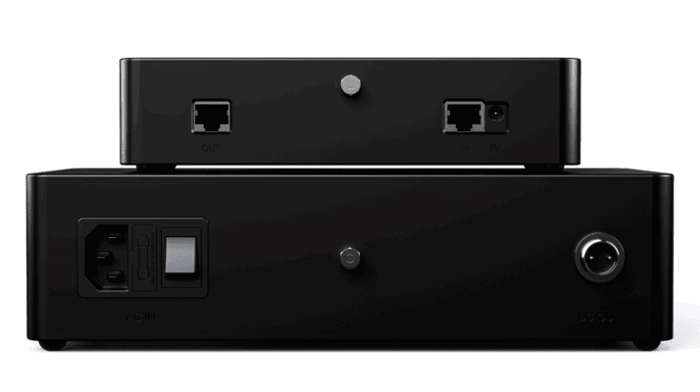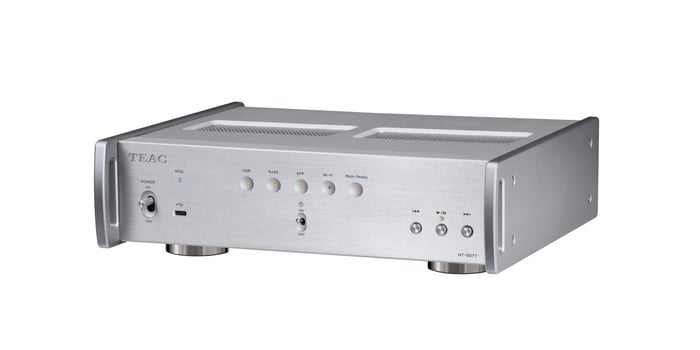
Reiki Audio SuperSwitch and OpticalBridge: Elevate Your Streaming Sound Quality
Reiki Audio SuperSwitch and OpticalBridge: Elevate Your Streaming Sound Quality
Explore how Reiki Audio’s innovative SuperSwitch and OpticalBridge reduce noise to transform your streamer’s audio experience.
If you’ve ever sunk into the world of high-fidelity audio, you know there’s an audiophile version of almost everything — even the humble power cord. So, it shouldn’t surprise you that network switches, those often-overlooked traffic controllers of your LAN, have now been treated to the audiophile makeover as well.
When streaming your favorite tunes—especially if you're using platforms like Roon—you rely on a network switch to ferry data seamlessly. Traditionally, these switches are viewed as mere workhorses that don’t influence sound quality. You can snag a reliable Cisco or Netgear for about $50 at your local electronics store, but audiophile-grade switches by brands like Nordost can cost a small fortune.
But here’s the twist: Reiki Audio’s SuperSwitch and OpticalBridge are not your typical network switches. Despite the SuperSwitch’s name, both devices feature just one input and one output port — technically making them bridges, not switches. They’re designed to sit between your existing network switch and your DAC or streamer, with one simple mission: to reduce noise contaminating your precious audio signal.
Why Does Noise Reduction Matter in Digital Audio?
Let’s clear the air first: Ethernet is a marvel of digital communication. It’s self-correcting, ensuring that ones and zeroes never get scrambled or lost along the way. Noise on the Ethernet line won’t corrupt the data itself.
So then, why fuss over noise at all?
Because noise isn’t just about data integrity. Noise—whether digital interference from your switch, grounding issues in cables, or electromagnetic and radio frequency interference from the environment—can sneak into your DAC’s digital module. From there, it can bleed into the analog side, where our ears finally catch it. The result? A raised noise floor that smudges the purity of your music, adding grainy textures and masking subtle layers that make listening immersive.
Audiophile switches aim to minimize noise production and shield themselves from outside interference—think rugged aluminum chassis and careful electrical engineering.
Reiki Audio takes a different route. Instead of hoping your network switch and cables handle noise, their gear stops upstream noise right before it reaches your DAC, effectively acting as a final noise gatekeeper. This approach lets you use standard switches and cables while still achieving cleaner sound, by inserting one simple component between your switch and streamer.

Meet the SuperSwitch: Noise Blocking in a Compact Package
The SuperSwitch is beautifully minimalist—just one Ethernet input (from your existing network switch) and one output (to your streamer or DAC). Reiki Audio insists that the cable running from the SuperSwitch to your DAC be very short (1.5 to 3 feet) and unshielded twisted pair (UTP), such as Cat6a. Why? Because shielded cables can conduct interference, defeating the purpose.
If you want to go all in, Reiki offers the Raku-Stream+, their own high-end Ethernet cable with a unique shield grounded only at one end to minimize noise.
Built like a tank, the SuperSwitch sports a thick aluminum shell with no holes, switches, or flashy lights, all to keep RFI and EMI out. Inside, the circuitry is painstakingly shielded, ensuring the signal passes through quietly and cleanly.
Power-wise, the SuperSwitch comes with an iFi switch-mode PSU, which works well but does introduce a bit of noise. For those who want to squeeze every last bit of clarity, Reiki offers the SuperSwitch Pro, a low-noise linear PSU upgrade.

The OpticalBridge: Noise Elimination via Optical Isolation
OpticalBridge takes a different tack. It comes in pairs—two slim units each with a single Ethernet port. One connects to your network switch, the other to your DAC/streamer.
Each unit requires its own power supply—supplied are two iFi PSUs, but again, you can upgrade to two SuperSwitch Pro linear PSUs for even cleaner power.
The magic happens in the link between the two units: a supplied optical cable carries the signal as light, meaning no electrical noise can travel across it. This optical isolation effectively halts noise dead in its tracks, offering a truly pristine connection.
Putting Reiki’s Noise-Reducing Gear to the Test
Reiki’s product line is extensive, with many permutations and options. To keep things clear, four key configurations stood out as offering the best blend of performance and cost:
- Configuration 1 (C1): SuperSwitch + iFi PSU ($1,960)
- Configuration 2 (C2): SuperSwitch + Pro Linear PSU ($3,980)
- Configuration 3 (C3): OpticalBridge + 2 x iFi PSUs ($3,990)
- Configuration 4 (C4): OpticalBridge + 2 x Pro Linear PSUs ($8,450)
My streaming setup was already quite refined: high-quality CAT6a UTP cables, a low-noise generic switch, a CH Precision I1 DAC/streamer, and Roon. So improving on this baseline was no small feat.
Yet, all four configurations delivered noticeable sonic improvements, though with some caveats worth noting.
C1: The SuperSwitch with iFi PSU
This entry-level setup sharpened bass and widened the soundstage nicely—take Zero7’s “In the Waiting Line,” for example. But on demanding classical tracks like the first movement of Stravinsky’s L’Histoire du Soldat, the dynamics felt compressed and highs less extended. It was a good start, but not my top pick.
C2: SuperSwitch with Pro Linear PSU
Now we’re talking. Swapping in the Pro linear PSU brought dynamics and sparkle back, while preserving the improved bass articulation. Vocals became smoother and less raspy—check out the Stones’ “Let It Bleed.” On more complex tracks like Wes Montgomery’s “’Round Midnight” or the Stravinsky piece, the background was notably quieter.
George Harrison’s voice on “I’d Have You Anytime” from the remixed All Things Must Pass suddenly sounded far more lifelike and transparent. This configuration was tough to beat.
C3: OpticalBridge with iFi PSUs
The OpticalBridge knocked the noise floor down even further than the best SuperSwitch setup. Until you experience it, you might not realize that even top Ethernet cables carry a whisper of background noise. With the OpticalBridge, that noise evaporates. The presentation is holographic, with instruments floating in a genuine silence.
Listening to Zero7’s “In the Waiting Line” again, I could finally distinguish harmony parts on the chorus—a thrilling “aha” moment for any audiophile.
C4: OpticalBridge with Pro Linear PSUs
Adding the Pro linear PSUs here yielded a subtle but real improvement—marginally quieter backgrounds and a touch more depth when the recording was good. It’s a premium step for those chasing the last fraction of performance.
Choosing Your Champion: SuperSwitch or OpticalBridge?
While the OpticalBridge configurations (C3 and C4) offered the quietest background, they felt a bit too sterile to my ears—smoother but less dynamically vibrant.
Ultimately, I gravitated toward the SuperSwitch paired with the Pro PSU (C2). It showcased a more lively, engaging sound that retained plenty of clarity and resolved noise beautifully—even if it didn’t reach the absolute silence of the OpticalBridge.
Of course, your mileage may vary—this is a deeply personal aspect of audio enjoyment.
Conclusion: A Sound Investment in Clearer Streaming
Remember, these comparisons were made under a microscopic lens, pitting high-end Reiki gear against itself. Step back, and any Reiki configuration will significantly reduce noise compared to a typical non-Reiki streaming setup.
Reiki Audio succeeds in lowering the noise floor, resulting in tighter bass, silkier vocals, and uncovering musical details that often hide in the shadows.
While I haven’t tried competing audiophile switches head-to-head, Reiki’s approach clearly works—and it offers a tantalizing way to upgrade your streaming audio without overhauling your entire network.
Specs & Pricing
SuperSwitch
Input: RJ-45 10/100/1000BASE Ethernet port (Auto-negotiation)
Output: RJ-45 10/100/100BASE Ethernet port
Clock: 25MHz
Dimensions: 182mm x 45mm x 100mm
Weight: 850g
Price: $1,960 (with iFi PSU) / $3,980 (with Pro linear PSU)
OpticalBridge
Inputs: 1x 100/1000BASE-T RJ-45 port; 1x 100/1000BASE-SX/LX SFP slot
Operation: Full duplex (optical-electrical or electrical-optical)
Dimensions: 120mm x 33mm x 138mm
Weight: 700g
Price: $3,990 (with 2x iFi PSUs) / $8,450 (with 2x Pro Linear PSUs)
Reiki Audio Limited
Leicestershire, England
[email protected]
FAQ
- What is the main function of Reiki Audio’s SuperSwitch and OpticalBridge?
They reduce noise before it reaches your DAC, improving sound clarity by lowering the noise floor. - Can I use the SuperSwitch with any standard network switch?
Yes, the SuperSwitch works inline with your existing network switch and streamer/DAC. - What makes the OpticalBridge unique compared to the SuperSwitch?
The OpticalBridge uses an optical cable to connect two units, eliminating electrical noise across the connection completely. - Why does Reiki recommend using a short UTP cable from the SuperSwitch to the DAC?
Short UTP cables without shielding reduce the chance of interference being conducted into the DAC. - Are the power supplies important in these setups?
Absolutely—linear PSUs like the SuperSwitch Pro significantly reduce noise compared to standard switch-mode PSUs.
For those who appreciate music and visual art alike, why not bring the magic of your favorite album cover into your space? Shop your favorite album cover posters at Architeg Prints and add that special touch to your listening environment.
 | DISCOUNTGET 30% OFF*Use code on your next order:
|
* This post may contain affiliate links, meaning we earn a commission if you make a purchase through these links, at no additional cost to you.







